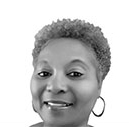
SHERRY CANNON
I attended a lecture at Bradley University by Dr. Simon Balto, an assistant professor of history and director of African-American Studies at Ball State University. The lecture was sponsored by Bradley’s department of history and was part of the Armstrong Lecture Series. The Wyckoff Room in the university’s library was filled, mainly with students. I was one of two African-Americans present.
Dr. Balto’s lecture title was “Occupied Territory: Thinking Historically About Racialized Policing in America.” He started the lecture by sharing a little personal information. Adopted at birth, he was raised in Wisconsin and moved to Chicago after graduating from University of Wisconsin-Madison.
After the lecture, I asked Dr. Balto a little more about his background. He was born to a 15-year-old Mulatto mother and a Saudi father and adopted by a Jewish family.
His first book, “Occupied Territory: Policing Black Chicago from Red Summer to Black Power,” is scheduled to be published this year. His book and this lecture both come from his doctoral research.
Dr. Balto’s lecture centered around policing in Chicago but deals with policing throughout the United States. He stated that police forces and systems are instruments of racial repression. The United States is the world’s leader in incarceration of its citizens. He contends that from 1945-1970 you can trace Chicago’s pivotal turn to systematically repressive policing.
He identified three hallmarks of this system:
- Over patrolling — Predominately Black communities are saturated with police presence. Stop and frisk, racial profiling, assumption of criminality, suspension of habeas corpus rights and disproportionate exposure to police violence.
- Under protection — Police personnel is doubled, budget is quintupled, the city begins to disinvest in schools and community health centers.
- Expanding power and discretion of police — This expansion was not accompanied by expanding oversight. Many Blacks were subject to torture and increased brutality.
In 1940, there were 280,000 African-Americans in Chicago. By 1970, the African-American population was close to one million. This was the result of the “Great Migration” that occurred between 1916-1970 when six million African-Americans from the rural Southern part of the country moved to the urban Northeast, Midwest and West.
By 1950, most Black people lived in the West and Southside of Chicago. During this period, there was no meaningful increase in violent crimes. However, the public began to associate people in those communities with being criminally inclined. As those neighborhoods became blacker due to white flight, the remaining white citizens demanded greater police presence. White race riots broke out resisting integration in other parts of the city. Today much of Chicago is still segregated.
A movement arose called Chicago Reform Voices. The Chicago Crime Commission and Alderman Robert Merriam were vanguards of this movement. They challenged the corrupt Chicago Police Department. During this time, policing was not considered an honorable occupation, nor was it well-paid.
In 1955, Richard J. Daley was the leader of the Cook County Democratic Party. The current Democratic mayor was corrupt along with the police department. Daley inserts himself into the mayoral race running on a platform of law and order and an expansion of the Chicago Police Department.
After Daley won the mayoral race, the shift from neighborhood policing to tactical squads began. More police were hired, they became more aggressive and given more discretion on whom to target. These tactical squads only operated in Black neighborhoods during that time, but later became the template for the whole department.
In 1958, The Chicago Crusader, a local African-American newspaper, wrote, “In the eyes of the police, no Negro has any rights that a police officer is bound to respect.” Dr. Balto drew the correlation to The Crusader’s description of Chicago’s policing of African-Americans and the Supreme Court’s decision in the 1857 Dred Scott Case. In that decision the court ruled no Black, free or slave, could claim U.S. citizenship, and therefore Blacks were unable to petition the court for their freedom.
In 1960, Orlando Wilson became the Chicago Police Department superintendent. He was considered a racial moderate, but under his leadership, police efficiency was measured by number of stops.
Despite the growth of the police department’s budget, Chicago becomes more violent. And even though Black communities lived under a police regime, they had less protection. Often flyers were circulated by African-Americans trying to get information on killings of Black men by police.
A 1964 confidential memorandum predicted that Chicago will see a growing Black population and a decrease of its white population, and crime will increase by 20 percent. There will therefore need to be increased funding for the Chicago Police Department to manage this. By 1970, the city was spending $200 million annually on policing.
The arrest of its Black citizens increased, while the arrest of white Chicagoans almost disappeared. By 2018, the Chicago police arrest about 13,000 white people a year. There are 2.705 million people living in Chicago, Whites are 32.6 percent of the population, Hispanics 29.7 percent and African-Americans make-up 29.3 percent. Since 2000, Chicago’s Black population has dropped by more than 250,000 people.
Dr. Balto took a few questions after his lecture. He concluded the Q&A by saying the first Black Chicago Police superintendent said the police department’s mission is to contain and control.

Recent Comments